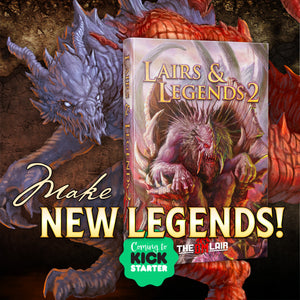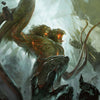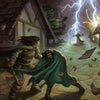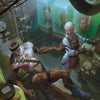Top 14 Mistakes of High-Level D&D
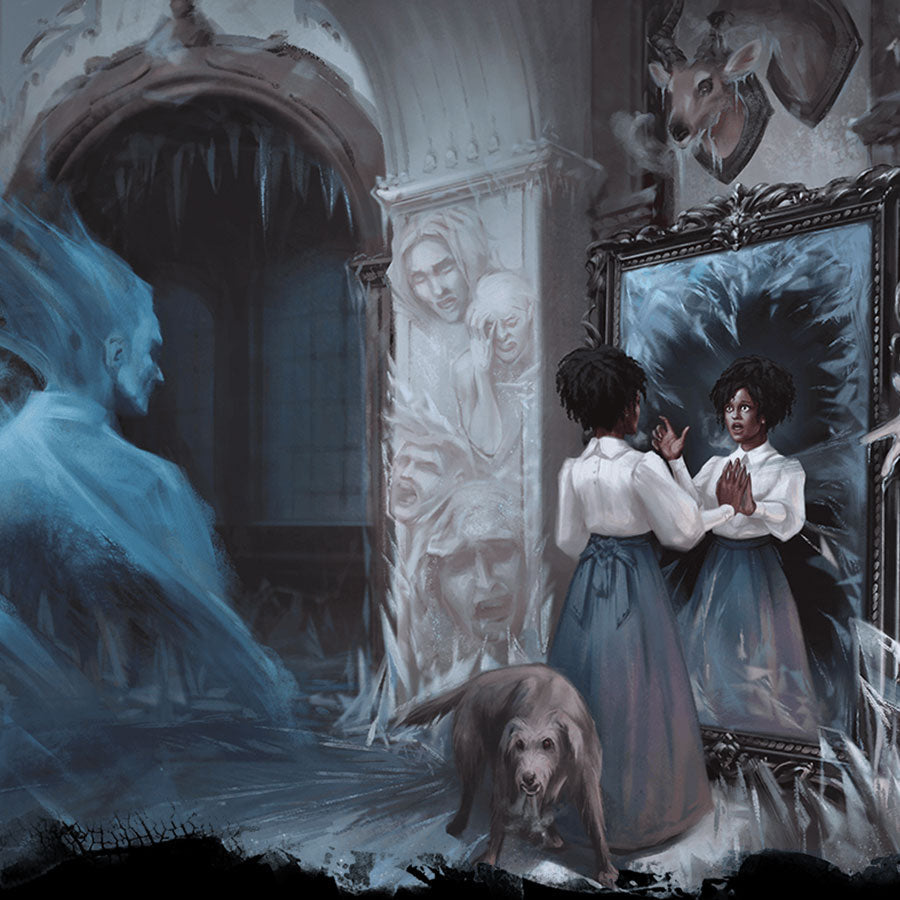
By Luke Hart
High-level D&D is a beautiful disaster waiting to happen.
You’ve got wizards bending reality, clerics bringing back the dead, monks stun-locking bosses, and druids turning into kaiju. Sounds epic, right?
Until the DM pulls out another goblin cave, half the party teleports past the dungeon, and the rogue uses one combo to delete your villain before she even finishes her evil monologue.
It’s not your fault. High-level D&D isn’t just more powerful—it’s an entirely different game. And most DMs weren’t taught how to run it.
Today we’re going to break down the worst mistakes DMs often make when running high-level adventures—and show you exactly how to fix them. We’re talking combat, roleplay, worldbuilding, pacing, and the one thing that separates a legendary session from a total burnout.
Because you can run high-level D&D. You just can’t run it like it’s level five anymore.
By the way, are you a NEW GAME MASTER feeling a bit overwhelmed by everything involved with running a role-playing game? If so, the Secret Art of Game Mastery can help. Get over 100 years of GM experience distilled into practical, easy-to-read advice.
Watch or listen to this article by clicking the video below.
1. Same Tricks, Bigger Disappointments
The party was level 15, and the dungeon master had clearly just copy-pasted a low-level cave crawl only with the encounters ramped up. So, you had things like pit traps, locked doors, and a 60-foot chasm with no bridge. You could see the confusion on his face when the sorcerer just cast fly, the rogue teleported across the pit, and the cleric wordlessly walked through a wall using etherealness.
Ten minutes in, and half the dungeon’s challenges were irrelevant. The players were bored. The DM was scrambling. Nobody was having fun.
This is the trap of running high-level adventures like they’re still level 5. The old tricks don’t work anymore.
By this point, characters can fly, teleport, see in magical darkness, ignore terrain, and shrug off most traps. If you want to challenge them, you have to adapt.
Design smarter. Make obstacles that can’t just be bypassed with a spell. Give your monsters real tactics—not just hit points and damage. I can’t recommend The Monsters Know What They’re Doing enough. Study how creatures behave. Make enemies act like they want to live.
High-level D&D is a chess match, not a game of whack-a-mole. And if you’re still using goblin cave logic… the characters may win, but the players and dungeon master will lose.
2. You Should’ve Seen That Coming
The wizard upcast banishment to get rid of the mooks, the rogue used evasion to dance through a level 9 meteor swarm, the paladin dropped Holy Aura and spat out heals, and the monk stun-locked the boss before it even got a turn.
The dungeon master blinked. Stared at his notes. And muttered something about how this was supposed to be the hard fight.
And that’s when it hit me—he had no idea what our characters could actually do.
At high levels, this is a fatal mistake.
These characters aren’t scrappy adventurers anymore—they’re legends. And if the villains and adventures aren’t designed with those capabilities in mind, the whole game collapses under its own power creep.
If you're running high-level adventures, you need to know your party’s abilities better than they do. What spells do they rely on? What combos do they love? What are their weaknesses? What do they always forget?
And more importantly, so should the villains.
Powerful enemies should anticipate those tactics. They’ve done their homework. They’ve seen the party’s legends spreading across the realms—and they’re ready.
Build encounters and adventures that don’t just react to the party, but actively counter them. Make your players feel clever for succeeding—not bored because nothing pushed back.
3. Let Them Be Legends
The dungeon master scaled every encounter to match our level perfectly. Every fight was finely tuned, every boss immune to our favorite tricks, every moment a challenge.
And it was exhausting.
One session, after barely scraping through our third “balanced” encounter of the night, the barbarian leaned back and said, “Man... I don’t feel like a level 17 hero. I feel like I’m still struggling through level 5.”
And he was right.
At high levels, the goal isn’t just challenge—it’s fantasy fulfillment.
Let the players feel like demigods sometimes. Let them sweep through armies of lesser foes. Let villagers gasp when they arrive. Let enemies flee in terror. Not every fight has to be a nail-biter. Some should be a reminder of just how far they’ve come.
Design moments for glory. Fights that are too easy, on purpose. Let them walk into a royal court and get treated like the world-shaking heroes they are.
Yes, you still need tension and drama. But if your high-level game never pauses to say, “Dang, you’re amazing”—then what’s the point of leveling up?
4. Stop Saving the Village
We were level 18. We’d slain dragons, battled liches, closed rifts in time.
And now? We were escorting a merchant caravan to a backwater hamlet because someone had been stealing sheep. The wizard looked at me like I’d insulted his PhD. The barbarian refused to rage. The cleric healed the sheep out of spite.
Look—by the time your party hits the upper levels, they’re not just heroes anymore. They’re icons. World-shakers. Reality-breakers. So if your stakes are still “bandits in the woods,” it’s going to fall flat.
At this level, your adventures need to feel epic. The world should be teetering on the brink. Maybe the universe. Maybe all of them.
High-level adventures are where the gods start paying attention. Where a single decision can reshape history. Where the fate of existence might hang on who wins this next initiative roll.
Give them stakes that match their power. That’s when high-level play stops being just high numbers—and becomes unforgettable.
5. Make It Personal
The villain stood atop the burning tower, grinning. “Tell Jareth the Bladesinger,” he said, “that his mentor screamed just before the end.”
The table went dead silent.
Jareth’s player leaned in, his knuckles white around his character sheet. “Oh,” he whispered, “he dies today.”
At high levels, numbers don’t matter as much as emotion. If the campaign still feels like a series of disconnected quests with no personal stakes, you’re missing the best part of high-level play.
By now, these characters should have rivals, enemies, regrets, and attachments. So use them.
Let the villains come back from the dead—they have access to resurrection, too. Let them remember past humiliations and hunt down the party for revenge. Let them go after the party’s loved ones, home cities, or even their favorite magic items. Make the players feel like their choices have earned both praise and wrath across the world.
The enemies should know the characters’ names and YEARN for the prestige of taking them down.
This is when the dice start shaking in people’s hands.
6. Go Somewhere Worthy
We were level 19 and standing in a perfectly ordinary forest. Again. The fifth session in a row. The druid actually asked, “Are we ever going to leave Faerûn?”
That’s when it hit me—this game had epic-level characters, but low-level locations.
At high levels, the party shouldn't just be dungeon-crawling through caves and abandoned towers. They should be plunging into Hell. Climbing the Infinite Staircase. Navigating the endless battles of Acheron, or trying not to get eaten by the Abyss.
Even the Prime Material plane has hostile environments that can be brutal if you don’t handwave them. Blistering deserts. Frozen wastelands. Acidic swamps that eat through armor. Make the world part of the danger.
And here’s the trick—don’t skip the environmental rules. Exhaustion from heat, freezing damage, suffocating smoke—these things matter, especially when layered over a combat or a mission objective.
High-level adventures aren’t just about who you fight, but where you fight them. When the location itself wants the party dead, that’s when the game really starts to feel epic.
And now let’s talk about the biggest problem with high-level D&D: combat.
7. If It’s Gonna Be Long, Make It Good
The final battle had begun. One boss. Four lieutenants. Three waves of reinforcements. Over 800 combined hit points. And after 90 minutes of initiative cycling, we had only just bloodied the big guy.
Someone sighed. Someone else went to get snacks. The tension? Gone.
High-level combat takes time. That’s just reality. So, if you’re going to be in a battle for an hour or two, it needs to stay engaging.
Don’t just throw a mountain of hit points at the table. That’s not a challenge—it’s a chore.
Instead, reduce hit points and boost damage output. Make enemies hit hard and die faster. You’ll still pressure the party’s resources without dragging things out.
Layer in terrain effects. Lair hazards. Shifting objectives. Use weaker enemies to bog the party down before they can reach the real threat—and speed up their turns using the Mob Attacks rules from the 2014 DMG.
The goal isn’t just to run a long fight. The goal is to run a long fight that feels like an epic event—not a slog through spreadsheets.
8. CR Lies to You at This Level
The paladin one-shot the boss. Not a boss—the boss. The final enemy of the dungeon. Smote right off the initiative tracker before it even took a turn.
The dungeon master stared down at the stat block and said, “But it was rated as Deadly…”
Yeah. No. Not anymore.
At high levels, Challenge Rating breaks down. What used to be “Deadly” at level 5 is now just Tuesday.
Once your party hits Tier 3 and 4, you need to recalibrate what “hard” even means. Deadly encounters might become the default. “Two times Deadly” should be your boss fight baseline—and they’ll still win, if they’re smart.
Now maybe 2024 D&D improved how CR works, I don’t know. I haven’t played it enough. And frankly, I have no idea if playtesting at high-levels was even done. So, I guess we’ll see.
Anyway, want to keep pressure on without spiking difficulty too fast? Replace your old Easy encounters with “High Medium” or “Hard” ones. These can whittle down hit points and spell slots without killing the pace. It’s resource attrition disguised as action.
But please—don’t rely on CR to tell you what’s dangerous anymore. Your party has been breaking the math since level 11. It’s time to challenge them like the legends they are.
9. Why Are Only the Players Leveling Up?
The party was level 18 and had been steamrolling everything in their path. Then they kicked down the door and found themselves face to face with a mind flayer... with levels in wizard.
And suddenly, things weren’t so easy.
The mind flayer dropped a meteor swarm before combat even started, counterspelled the cleric’s heal, and vanished with greater invisibility. That was the first time in several sessions the table actually looked nervous.
If the player characters keep leveling up, why shouldn’t the monsters?
Giving monsters class levels is one of the best tools you have to keep high-level play interesting. A troll with barbarian rage. A vampire with levels in warlock. An archmage with rogue sneak attack. It’s a game-changer.
Yes, this absolutely messes with Challenge Rating. And yes, you’ll have to experiment. Trial and error is part of it—and don’t be afraid to adjust on the fly if the fight’s too easy or too punishing.
But when done right, class-leveled monsters don’t just raise the challenge—they tell better stories. They make your villains feel just as crafty and powerful as the players.
And at this level? That’s exactly what they need.
10. Break the Party, Not the Game
The party won. Again. Barely scratched. And the DM was baffled.
The villain had minions, lair actions, legendary resistances—the whole package. But the party stuck together in a perfect little formation, buffed each other, and dismantled the encounter like clockwork.
It wasn’t a bad fight. It was a too safe fight.
At high levels, your players are a well-oiled machine. They’ve got synergies, combos, and enough healing to undo half your prep. So break that machine apart—split the battlefield.
Drop a wall of force. Trigger a cave-in. Use flying enemies to isolate the casters. Make them fight on multiple fronts where they can’t rely on constant support.
And while you’re at it, ditch the one-and-done monster drop.
Try waves instead. Three fast waves of “easy” enemies will wear down the party’s resources way more effectively than one “balanced” encounter—and the constant shift keeps players on their toes.
Advanced encounter design isn’t just about mechanics—it’s about momentum. Use isolation, pressure, and escalation to push high-level parties out of their comfort zone.
Make them earn their legendary status.
11. No, You Don’t Get to Rest Again
We had just finished a tough fight. Spell slots drained. Hit points low. And the wizard looked at the DM and said, “Okay, long rest?” The DM shrugged. “Sure.”
And just like that, every ounce of tension vanished.
At high levels, the biggest danger to your encounters isn’t your monsters—it’s the long rest. If your party can rest after every fight, they’ll always be at full power. That’s not challenge—that’s a buffet.
So you have to push back.
Start by throwing more encounters per day. Don’t let them clean up, nap, and come back fresh. Stack encounters. Overwhelm them with pace. Put them on a timer—a city burning, a ritual nearing completion, a villain escaping.
And when they do want to rest? Make it hurt. Let them know that resting gives their enemies time to regroup, innocents time to die, and bad guys time to dig in harder.
Rest should be a strategic decision, not a knee-jerk reflex.
High-level adventuring is a war of attrition. If they don’t feel the pressure, you’re giving them too much breathing room—and they’ll steamroll everything.
And if you think that sounds like a slog, don’t blame me. Blame the game designers. Or play a different game system that doesn’t rely on the adventuring day mechanic and resource depletion. But you wanted advice about high-level D&D, so here it its.
12. Magic Isn’t a Free Win Button
The wizard cast disintegrate. The enemy failed the save. Boom—fight over in six seconds.
The next session, he tried it again… but this time, in a wild magic zone. The spell rebounded, turned his robes into butterflies, and left him standing there, very confused, very unarmed, and very pink.
High-level casters are terrifyingly powerful. If you don’t push back against that magic, it will dominate your encounters. So the trick is simple: make magic harder.
Use wild magic zones, dead magic zones, or areas where the Weave is unstable. Give enemies access to counterspell and dispel magic—especially intelligent villains who know the party relies on magic. Even basic foot soldiers with scrolls can become a real threat.
Throw in more enemies with magic resistance or legendary resistances. And don’t be afraid to build entire encounters that force the party to rely on their martial characters. Maybe spellcasting is unstable. Maybe conserving spells becomes critical.
The goal isn’t to nerf the wizard—it’s to make their choices matter. If every spell always works, casting becomes mindless. But if they have to think about when and how to use magic? Now you’ve got tension.
13. Stop Making Every Fight a Slaughter
The fight was going fine. Too fine. The monk was stun-locking enemies. The wizard was nuking everything. The rogue was making sneak attack look like a war crime.
Then the villain’s lieutenant reached the back of the room and started casting a ritual.
Suddenly, no one cared about hit points anymore.
That’s the secret: combat doesn’t have to be about reducing things to 0 HP.
Give your high-level players objectives. Make them stop a ritual. Prevent an enemy from sounding the alarm. Force them to protect hostages, escort vulnerable NPCs, or grab a magical artifact while holding off waves of enemies.
Better yet? Trap them in a collapsing dungeon and give them ten rounds to fight their way out—after they’ve burned all their teleportation spells. Nothing gets a high-level table sweating like a ticking clock.
This kind of combat changes the vibe. It’s not just a numbers game anymore—it’s a narrative challenge with real stakes and tough choices.
Because when your players stop asking, “How fast can we kill them?” and start asking, “How do we pull this off?”—you know you’ve nailed high-level play.
14. You Can’t High-Level Without Trust
The cleric cast simulacrum to double the party's spellcasting. The wizard used wish to bypass the entire dungeon. The sorcerer quickened telekinesis to toss the boss off a cliff before initiative even started.
And the DM? He looked like he was rethinking every life decision that led him to this table.
High-level D&D isn’t just about big numbers and flashy spells—it’s about collaboration. If your players are only here to break the game, find loopholes, and cheese their way to victory, high-level play is going to collapse fast.
This tier of play requires trust. Communication. A shared understanding that everyone’s here to play the same game—not run a competition for most overpowered combo.
Talk to your players. Set expectations. If a spell, combo, or feature is breaking the game, pause and discuss how to handle it together. Adjust as a group so the game stays fun and challenging for everyone.
And let’s be honest—some players just aren’t built for high-level play. If someone only takes joy in exploiting the system, they’re not contributing to the story. They’re eroding it.
High-level D&D only works when everyone’s on the same page.
100 Years of GM Experience at Your Fingertips!
Are you a NEW GAME MASTER feeling a bit overwhelmed by everything involved with running a role-playing game? Are you a VETERAN GAME MASTER looking for new tips and tricks to take your games to the next level? Look no further than the Secret Art of Game Mastery.
We at the DM Lair have distilled our CENTURY of accumulated GM experience into an easy-to-read guide of practical advice that you can immediately apply to your games! We've even included our own templates–the things that we use to prepare our ACTUAL games.
Get all three books to master your game:
- The Secret Art of Game Mastery. Contains over 100 years of GM advice distilled into an easy-to-read format. It introduces and explains the tools of the trade, scheduling, playstyle, post-game notes, getting player feedback, and more.
- The Secret Art of Preparation. Brings to your fingertips the actual templates and guides that the DM Lair team uses to prepare games, Lair Magazine, and more. Designed as a three-ring binder, it's intended for you to write directly into for your entire campaign!
- The Secret Art of Notetaking. Gives you the keys to tracking your campaign from session to session just like the DM Lair team. Designed as a three-ring binder, it's intended for you to write in and keep track of your whole campaign!
With so much knowledge and experience on its pages, The Secret Art of Game Mastery is guaranteed to become an indispensable tool for all game masters, new and veteran alike. And if that isn’t enough, the information applies to all game systems and all genres!
-
Posted in
Game Master How-To Articles


